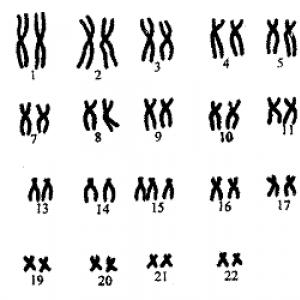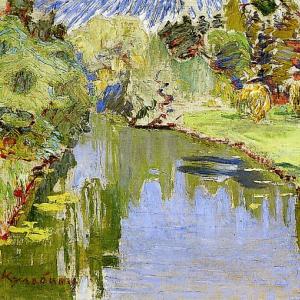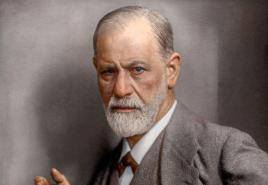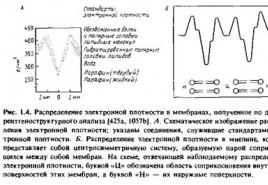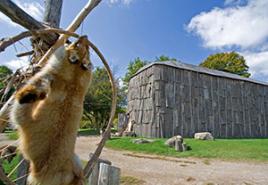Methodology for analyzing a karyogram and describing a human karyotype. What is an autosome in biology? 44 autosomes
First write down the task number (36, 37, etc.), then the detailed solution. Write down your answers clearly and legibly.
What are the signs of venous bleeding?
Show answer
1) Blood is dark red or cherry color
2) Blood flows out of the wound evenly, slowly, without pulsating
What modified shoot is shown in the picture? Name the structural elements indicated in the figure by numbers 1, 2, 3, and the functions that they perform.
Show answer
1) The picture shows an onion.
2) The number 1 indicates scale-like leaves; they contain nutrients.
3) The number 2 indicates adventitious roots; they absorb water and mineral salts from the soil.
4) The number 3 indicates the buds, shoots will develop from them.
Find three errors in the given text. Indicate the numbers of the sentences in which they are made, correct them.
1. In meiosis, two successive divisions occur. 2. Between two divisions there is an interphase in which replication occurs. 3. In prophase of the first division of meiosis, conjugation and crossing over occur. 4. Crossing over is the bringing together of homologous chromosomes. 5. The result of conjugation is the formation of crossover chromosomes.
Show answer
Errors were made in the following sentences:
2 – Between two divisions there is an interphase in which replication does not occur.
4 – Crossing over is the exchange of sections of homologous chromosomes.
5 – The formation of crossover chromosomes is the result of crossing over.
What characteristics are characteristic of bryophytes?
Show answer
1) There are no roots, instead of them there are rhizoids (attachment organs).
2) Poorly developed tissues, especially mechanical and conductive ones.
3) The gametophyte predominates in the life cycle.
How does a natural ecosystem differ from an agroecosystem?
Show answer
1) The natural ecosystem has a large diversity of species, and the agroecosystem is dominated by plants of one species.
2) In a natural ecosystem, food chains are longer and more branched than in an agroecosystem.
3) In a natural ecosystem the cycle of substances is closed, while in an agroecosystem it is open.
As a result of a mutation in a fragment of a human protein molecule, the amino acid glycine (Gly) was replaced with aspartic acid (Asp). Determine the amino acid composition of fragments of the protein molecule of a sick person and a healthy person, possible fragments of mRNA of a sick person, if normally this protein fragment corresponds to the following mRNA fragment: UUUUCUUUACAAGGUTSAUATSU. Explain your answer.
Rules for using the table
The first nucleotide in the triplet is taken from the left vertical row, the second from the top horizontal row, and the third from the right vertical row. Where the lines coming from all three nucleotides intersect, the desired amino acid is located.
Show answer
mRNA of a healthy person: UUU UCU UUA TsAA GGU TsAU ACU
Amino acids: fen ser lei gln gly gis tre
After replacing gly with asp:
Amino acids: fen ser lei gln asp gis tre
Since the amino acid asp corresponds to two codons (GAU and GAC), then
mRNA of a sick person: UUU UTSU UUA TsAA GAU TsAU ATSU
or UUU UCU UUA TsAA GAC TsAU ACU
When a pied crested (B) hen was crossed with the same rooster, eight chickens were obtained: four pied crested chickens, two white (a) crested chickens and two black crested chickens. Make a diagram for solving the problem. Determine the genotypes of parents and offspring, explain the nature of inheritance of traits and the appearance of individuals with variegated colors. What law of heredity is manifested in this case?
Show answer
2) Some of the offspring have a trait that is intermediate between the traits of the father and mother (variegated plumage), therefore, this is an intermediate nature of inheritance (incomplete dominance).
3) In this case, Mendel’s third law (the law of independent inheritance) is manifested.
Problem 1
Analyze the human karyogram (Fig. 1).
Rice. 1. Human karyogram.
Solution:
Karyogram
human contains 47 chromosomes. Most chromosomes are arranged in order of decreasing size. These are autosomes, there are 44 of them. In the bottom row, to the side of them, there are three chromosomes. These are sex chromosomes. All autosomes are presented in pairs. There are a total of 22 pairs of autosomes in the karyogram. There are 3 sex chromosomes. Two of them are large and their primary constriction - the centromere - is located almost in the middle. These are X chromosomes. Next to them is a small chromosome with a primary constriction located closer to the edge of the chromosome. This is the Y chromosome. The karyogram belongs to a male representative, since there is a Y chromosome. The karyogram contains an anomaly: an extra X chromosome. This karyogram is typical for males suffering from Klinefelter syndrome: patients have a eunuchoid physique, sometimes enlarged mammary glands, weak facial hair, often have mental retardation, infantilism, and are infertile. The human karyotype formula is 47, XXY.
Answer:
The human karyotype formula is 47, XXY. Klinefelter's syndrome.
Problem 2
Describe :
1) total number of chromosomes, 2) number of autosomes, 3) number of sex chromosomes, 4) gender (male or female), 5) number of X-chromatin clumps, 6) normal or pathological (what disease) (Fig. 2).

Rice. 2. Human karyogram.
Solution:
Karyotype description
:
2) number of autosomes – 45 autosomes, trisomy on the 15th pair of chromosomes.
3) the number of sex chromosomes – 2 XX chromosomes.
4) female gender – the karyogram belongs to a representative of the female gender (XX chromosome).
5) number of X-chromatin clumps – 1 clump.
6) normal or pathological (what disease) - the karyogram contains an anomaly: an extra 15th chromosome. This karyogram is typical for individuals suffering from Pattau syndrome.
The human karyotype formula is 47, XX.
Answer:
The human karyotype formula is 47, XX. Pattau syndrome.
Problem 3
Describe the karyotype:
1) total number of chromosomes, 2) number of autosomes, 3) number of sex chromosomes, 4) gender (male or female), 5) number of X-chromatin clumps, 6) normal or pathological (what disease) (Fig. 3).

Rice. 3. Human karyogram.
Solution:
Karyotype description:
1) the total number of chromosomes is 49 chromosomes.
3) the number of sex chromosomes is 5 (3 X chromosomes and 2Y chromosomes).
5) number of X-chromatin clumps – 2 clumps (presence of XXX chromosomes).
6) normal or pathological (what disease) - the karyogram contains an anomaly: an extra Y chromosome and two extra X chromosomes. This karyogram is typical for individuals suffering from Klinefelter syndrome; in the karyotype of a man, the total number of chromosomes is 49. Of these, 44 are autosomes and five sex chromosomes are XXXYY. This is a rare form of the disease Klinefelter syndrome. The human karyotype formula is 47, ХХХYY.
Answer:
The human karyotype formula is 47, ХХХYY. Klinefelter's syndrome (very rare form).
Problem 4
Describe the karyotype:
1) total number of chromosomes, 2) number of autosomes, 3) number of sex chromosomes, 4) gender (male or female), 5) number of X-chromatin clumps, 6) normal or pathological (what disease) (Fig. 4).

Rice. 4. Human karyogram.
Solution:
Karyotype description:
1) the total number of chromosomes is 46 chromosomes. 2) number of autosomes – 44 autosomes. 3) the number of sex chromosomes is 2 (2 X chromosomes). 4) female gender – the karyogram belongs to a representative of the female gender (XX chromosome). 5) number of X-chromatin clumps – 1 clump (presence of XX chromosomes). 6) normal or pathological (what disease) - the karyogram contains 46 chromosomes, of which 44 are autosomes and 2 X chromosomes, which means it is normal.
Answer:
The human karyotype formula is 46, XX. Healthy woman.
Problem 5
Describe the karyotype:
1) total number of chromosomes, 2) number of autosomes, 3) number of sex chromosomes, 4) gender (male or female), 5) number of X-chromatin clumps, 6) normal or pathological (what disease) (Fig. 5).

Rice. 5. Human karyogram.
Solution:
Karyotype description:
1) the total number of chromosomes is 48 chromosomes.
2) number of autosomes – 44 autosomes.
3) the number of sex chromosomes is 4 (2 X chromosomes and 2Y chromosomes).
4) male gender – the karyogram belongs to a male representative (YY chromosome).
5) number of X-chromatin clumps – 1 clump (presence of XX chromosomes).
6) normal or pathological (what disease) - the karyogram contains an anomaly: an extra Y chromosome and an extra X chromosome. This karyogram is typical for individuals suffering from Klinefelter syndrome; in the karyotype of a man, the total number of chromosomes is 48. Of these, 44 are autosomes and 4 sex chromosomes are XXYY. This is a form of the disease called Klinefelter syndrome.
Answer:
The male karyotype formula is 48, XXYY. Klinefelter's syndrome (rare form).
Problem 6
Describe the karyotype:
1) total number of chromosomes, 2) number of autosomes, 3) number of sex chromosomes, 4) gender (male or female), 5) number of X-chromatin clumps, 6) normal or pathological (what disease) (Fig. 6).

Rice. 6. Human karyogram.
Solution:
Karyotype description:
1) the total number of chromosomes is 47 chromosomes.
3) the number of sex chromosomes is 2 (1 X chromosome and 1 Y chromosome).
6) normal or pathological (what disease) - the karyogram contains an anomaly - an additional 21st X chromosome. This karyogram is typical for individuals suffering from Down syndrome; in the karyotype of a man, the total number of chromosomes is 47. Of these, 45 are autosomes and 2 sex chromosomes - XY
Answer:
The male karyotype formula is 47, XY. Down syndrome.
Problem 7
Describe the karyotype:
1) total number of chromosomes, 2) number of autosomes, 3) number of sex chromosomes, 4) gender (male or female), 5) number of X-chromatin clumps, 6) normal or pathological (what disease) (Fig. 7).

Rice. 7. Human karyogram.
Solution:
Karyotype description:
1) the total number of chromosomes is 45 chromosomes.
2) number of autosomes – 44 autosomes.
3) the number of sex chromosomes is 1 (1 X chromosome).
4) female gender – the karyogram belongs to a female representative (X chromosome).
5) the number of X-chromatin clumps is 0 (the presence of one X chromosome).
6) normal or pathological (what disease) - the karyogram contains an anomaly: lack of the X chromosome. This karyogram is typical for individuals suffering from Shereshevsky-Turner syndrome. In a woman’s karyotype, the total number of chromosomes is 45. Of these, 44 are autosomes and 1 sex chromosome is X.
Answer:
The karyotype formula for a woman is 45, X0. Lack of the X chromosome in the female karyotype - Shereshevsky-Turner syndrome.
Problem 8
Describe the karyotype:
1) total number of chromosomes, 2) number of autosomes, 3) number of sex chromosomes, 4) gender (male or female), 5) number of X-chromatin clumps, 6) normal or pathological (what disease) (Fig. 8).

Rice. 8. Human karyogram.
Solution:
Karyotype description:
1) the total number of chromosomes is 47 chromosomes.
2) number of autosomes – 45 autosomes.
3) the number of sex chromosomes is 2 (1 X chromosome and 1 Y chromosome).
4) male gender - the karyogram belongs to a male representative (Y chromosome).
5) the number of X-chromatin clumps is 0 (the presence of one X chromosome).
6) normal or pathological (what disease) - the karyogram contains an anomaly - trisomy on the 18th pair of chromosomes. This karyogram is typical for individuals suffering from Edwards syndrome; in the karyotype of a man, the total number of chromosomes is 47. Of these, 45 are autosomes and 2 sex chromosomes - X and Y.
Answer:
The male karyotype formula is 47, XY. extra chromosome 18 - Edwards syndrome.
Problem 9
Describe the karyotype:
1) total number of chromosomes, 2) number of autosomes, 3) number of sex chromosomes, 4) gender (male or female), 5) number of X-chromatin clumps, 6) normal or pathological (what disease) (Fig. 9).

Rice. 9. Human karyogram.
Solution:
Karyotype description:
1) the total number of chromosomes is 46 chromosomes. 2) number of autosomes – 44 autosomes. 3) the number of sex chromosomes is 2 (1 X chromosome and 1 Y chromosome). 4) male gender - the karyogram belongs to a male representative (XY chromosome). 5) the number of X-chromatin clumps is 0 (the presence of one X chromosome). 6) normal or pathological (what disease) - the karyogram contains 46 chromosomes, of which 44 are autosomes and XY chromosomes, which means the norm.
Answer:
The human karyotype formula is 46, XY. Healthy man.
Problem 10
Describe the karyotype:
1) total number of chromosomes, 2) number of autosomes, 3) number of sex chromosomes, 4) gender (male or female), 5) number of X-chromatin clumps, 6) normal or pathological (what disease) (Fig. 10).

Rice. 10. Human karyogram.
Solution:
Karyotype description:
1) the total number of chromosomes is 47 chromosomes. 2) number of autosomes – 45 autosomes. 3) the number of sex chromosomes is 2 (1 X chromosome and 1 Y chromosome). 4) male gender - the karyogram belongs to a male representative (XY chromosome). 5) the number of X-chromatin clumps is 0 (the presence of one X chromosome). 6) normal or pathological (what disease) - the karyogram contains an anomaly - trisomy on the 8th pair of chromosomes. This karyogram is typical for individuals suffering from Varkani syndrome; in the karyotype of a man, the total number of chromosomes is 47. Of these, 45 are autosomes and 2 sex chromosomes - X and Y.
Answer:
The human karyotype formula is 47, XY. Trisomy 8 - Varkany syndrome.
Studying a person's karyotype under a microscope is carried out using the cytogenetic method.
Karyotype- a set of chromosomes characteristic of somatic cells of a given organism.
Ideogram (systematized karyotype) - graphical representation of chromosomes, taking into account their absolute and relative length, centromeric index, the presence of a second constriction and a satellite.
The concept of Karyotype was introduced by Sov. geneticist G. A. Levitsky (1924). Karyotype is one of the most important genetic characteristics of a species, because Each species has its own Karyotype, which differs from the Karyotype of related species (a new branch of systematics is based on this - the so-called karyosystematics). The constancy of the karyotype in the cells of one organism is ensured by mitosis, and within a species by meiosis. The karyotype of an organism can change if the sex cells (gametes) undergo changes under the influence of mutations. Sometimes the karyotype of individual cells differs from the species karyotype as a result of chromosomal or genomic so-called somatic mutations. The karyotype of diploid cells consists of 2 haploid sets of chromosomes (genomes) obtained from one or the other parent; Each chromosome of such a set has a homologue from another set. The karyotype of males and females may differ in the shape (sometimes and number) of sex chromosomes, in which case they are described separately. Chromosomes in the Karyotype are examined at the metaphase stage of mitosis. Description The karyotype must be accompanied by a microphotograph or sketch. To systematize the karyotype, pairs of homologous chromosomes are arranged, for example, in decreasing length, starting with the longest pair; pairs of sex chromosomes are located at the end of the row.
Pairs of chromosomes that do not differ in length are identified by the position of the centromere (primary constriction), which divides the chromosome into 2 arms, the nucleolar organizer (secondary constriction), by the shape of the satellite, and other characteristics. The karyotype of several thousand wild and cultivated species of plants, animals and humans has been studied.
Autosomes - paired chromosomes, the same for male and female organisms. There are 44 autosomes (22 pairs) in human body cells
Sex chromosomes - chromosomes containing genes that determine the sex characteristics of an organism.
In the karyotype (qualitative and quantitative set of chromosomes) of women, the sex chromosomes are the same. In the karyotype of a man there is one large equal-armed sex chromosome, the other is a small rod-shaped chromosome.
Female sex chromosomes are designated XX and male sex chromosomes are designated XY. The female body forms gametes with identical sex chromosomes (homogametic organism), and the male body forms gametes with unequal sex chromosomes (X and Y).
In birds, butterflies and some species of fish, the male sex is homogametic. In a rooster, the karyotype is designated XX, and in a chicken, it is designated XY.
24. Gender, its predestination (progamous, syngamous, epigamous).
Floor - This is a set of characteristics and properties of an organism that determine its participation in reproduction.
The sex of an individual can be determined:
a) before fertilization of the egg by the sperm (programmatic sex determination);
b) at the moment of fertilization (syngamous sex determination);
c) after fertilization (epigamous sex determination).
Before fertilization, sex is determined in some organisms as a result of the division of eggs into fast and slow growing ones. The first (larger) after fusion with the male gamete give rise to females, and the second (small) give rise to males. In rotifers, which are capable of reproducing in addition to the usual sexual reproduction with fertilization, parthenogenetically, part of the parthenogenetic eggs lose half of their chromosomes during development. From such eggs males develop, and the rest gives rise to females.
In the marine annelid Bonellia, sex determination occurs during the process of ontogenesis: if the larva settles on the bottom, a female develops from it, and if it attaches to the proboscis of an adult female, then a male.
In the vast majority of eukaryotes, sex is determined at the moment of fertilization and is determined genotypically by the chromosome set that the zygote receives from its parents. The cells of male and female animals differ in their pair of chromosomes. This pair is called sex chromosomes (heterosomes) in contrast to the rest - autosomes. Sex chromosomes are usually referred to as X and Y chromosomes. Depending on their combination in organisms, there are 5 types of chromosomal sex determination:
1) XX, XO (O denotes absence of chromosomes) found in Protenor species (insects);
2) XX, XY - it is characteristic, for example, of Drosophila, mammals (including humans);
3) XY, XX - this type of sex determination is typical for butterflies, birds, and reptiles;
4) XO, XX - observed in aphids;
5) haplodiploid type (2n, n) is found, for example, in bees: males develop from unfertilized haploid eggs, females from fertilized diploid eggs.
The specific mechanisms linking the development of male or female sex with a certain combination of sex chromosomes varies from organism to organism. In humans, for example, gender is determined by the presence of the Y chromosome: it contains the TDP gene, it encodes the testicle - the determining factor that determines the development of the male sex.
In Drosophila, the Y chromosome contains the fertility gene, which is responsible for the fertility of the male, and sex is determined by the balance of the number of X chromosomes and the number of sets of autosomes (a typical diploid organism contains, respectively, two sets of autosomes). The X chromosomes contain genes that determine development along the female path, and the autosomes - along the male path.
If the ratio of the number of X chromosomes to the number of sets of autosomes is 0.5, then a male develops, and if it is 1, then a female develops.
In addition to normal males and females, intersex individuals sometimes appear - individuals whose sexual characteristics occupy an intermediate position between male and female (not to be confused with hermaphrodites!). This can be caused by both aneuploidy of sex chromosomes in gametes and various disorders (for example, hormonal) during the process of sex differentiation.
Problem 1
With Klinefelter syndrome in the karyotype of a man, the total number of chromosomes is 48. Of these, 44 are autosomes and four sex chromosomes are XXYY. What disorder of meiosis and in which of the parents led to the appearance of such an abnormal karyotype in the child? Draw up a diagram of the formation of this anomaly.
Solution:
In both parents, the sex chromosome did not diverge into chromatids during equational division (the second period of meiosis), one of the X chromosomes (or both X chromosomes) did not diverge in the mother, and the Y chromosome did not diverge in the father.
Problem 2
In X-chromosome tetrasomy syndrome, a woman’s karyotype has 48 chromosomes. Of these, 44 are autosomes and four are sex chromosomes. What disorder of meiosis and in which of the parents led to the appearance of such an abnormal karyotype in the child? Draw up a diagram of the formation of this anomaly.
Solution:

In both parents, the sex chromosome did not separate into chromatids during equational division (the second period of meiosis), and in the mother and father, the X chromosome did not separate into chromatids.
Problem 3
With Patau syndrome, a girl has a total number of chromosomes of 47, of which 45 are autosomes and two sex chromosomes. The reason for this anomaly is not the divergence of one pair of chromosomes from the 13th – 15th group of chromosomes. Draw up a diagram of the meiotic disorder that caused this disorder.
Solution:

Pairs of chromosomes diverge in reduction division, so the violation occurred in the first division of meiosis during spermatogenesis (in the father) or during oogenesis (in the mother). This diagram shows an example of a violation of chromosome segregation during oogenesis (solution 1) and spermatogenesis (solution.
Problem 4
With Edwards syndrome, a boy has a total number of chromosomes of 47, of which 45 are autosomes and sexual XY. The reason for this anomaly is not the divergence of one pair of chromosomes from group 16-18. Draw up a diagram of meiosis that caused this syndrome.
Solution:

Pairs of chromosomes diverge in reduction division, so the violation occurred in the first division of meiosis during spermatogenesis (in the father) or during oogenesis (in the mother). This diagram shows an example of a violation of chromosome segregation during oogenesis (solution 1) and spermatogenesis (solution 2).
Problem 5
In the syndrome, there are 47 chromosomes on the X chromosome in a woman’s karyotype. Of these, 44 are autosomes and three are sex chromosomes. What disorder of meiosis and in which of the parents led to the appearance of such an abnormal karyotype in the child? Draw up a diagram of the formation of this anomaly.
Solution:

Problem 6
In the syndrome, there is monosomy on the X chromosome in a woman’s karyotype of 45 chromosomes. Of these, 44 are autosomes and one sex chromosome. What disorder of meiosis and in which of the parents led to the appearance of such an abnormal karyotype in the child? Draw up a diagram of the formation of this anomaly.
Solution:

Problem 7
With Klinefelter syndrome in the karyotype of a man, the total number of chromosomes is 47. Of these, 44 are autosomes and three sex chromosomes are XYY. What disorder of meiosis and in which of the parents led to the appearance of such an abnormal karyotype in the child? Draw up a diagram of the formation of this anomaly.
Solution:

Problem 8
With Klinefelter syndrome in the karyotype of a man, the total number of chromosomes is 47. Of these, 44 are autosomes and three sex chromosomes are XXY. What disorder of meiosis and in which of the parents led to the appearance of such an abnormal karyotype in the child? Draw up a diagram of the formation of this anomaly.
Solution:

Problem 9
With Down syndrome, a girl has a total number of chromosomes of 47, of which 45 are autosomes and two are sex chromosomes. It is not the divergence of the 21st pair of chromosomes that causes this anomaly.
Draw up a diagram of the meiotic disorder that caused this anomaly.
Solution: Back
All other chromosomes in dioecious organisms will be autosomes. The presence, copy number, and structure of autosomes are independent of the sex of a given eukaryotic organism.
Autosomes are designated by serial numbers. Thus, a person has 46 chromosomes in the diploid set, of which 44 autosomes (22 pairs, designated by numbers 1 to 22) and one pair of sex chromosomes (XX in women and XY in men).
Autosomal diseases
Autosomal dominant diseases are often inherited from affected parents to their children, having a familial nature. A child born from a heterozygous carrier of a dominant mutation (if the second parent does not have a similar genetic disorder) has a 50% chance of being sick.
Write a review about the article "Autosoma"
Notes
Literature
- Griffiths Anthony J.F.. - New York: W.H. Freeman, 1999. - ISBN 071673771X.
|
||||||||||||||||||||||||||||||||||||||||||||||
Excerpt characterizing Autosome
“Ah, ma bonne, ma bonne, [Ah, darling, darling.],” he said, standing up and taking her by both hands. He sighed and added: “Le sort de mon fils est en vos mains.” Decidez, ma bonne, ma chere, ma douee Marieie qui j"ai toujours aimee, comme ma fille. [The fate of my son is in your hands. Decide, my dear, my dear, my meek Marie, whom I have always loved like a daughter. ]He went out. A real tear appeared in his eyes.
“Fr... fr...” Prince Nikolai Andreich snorted.
- The prince, on behalf of his pupil... son, makes a proposition to you. Do you want or not to be the wife of Prince Anatoly Kuragin? You say yes or no! - he shouted, - and then I reserve the right to say my opinion. Yes, my opinion and only my opinion,” added Prince Nikolai Andreich, turning to Prince Vasily and responding to his pleading expression. - Yes or no?
– My desire, mon pere, is never to leave you, never to separate my life from yours. “I don’t want to get married,” she said decisively, looking with her beautiful eyes at Prince Vasily and her father.
- Nonsense, nonsense! Nonsense, nonsense, nonsense! - Prince Nikolai Andreich shouted, frowning, took his daughter by the hand, bent her to him and did not kiss her, but only bending his forehead to her forehead, he touched her and squeezed the hand he was holding so much that she winced and screamed.
Prince Vasily stood up.
– Ma chere, je vous dirai, que c"est un moment que je n"oublrai jamais, jamais; mais, ma bonne, est ce que vous ne nous donnerez pas un peu d"esperance de toucher ce coeur si bon, si genereux. Dites, que peut etre... L"avenir est si grand. Dites: peut etre. [My dear, I will tell you that I will never forget this moment, but, my dearest, give us at least a small hope of being able to touch this heart, so kind and generous. Say: maybe... The future is so great. Say: maybe.]
- Prince, what I said is everything that is in my heart. I thank you for the honor, but I will never be your son's wife.
- Well, it’s over, my dear. Very glad to see you, very glad to see you. Come to yourself, princess, come,” said the old prince. “I’m very, very glad to see you,” he repeated, hugging Prince Vasily.
“My calling is different,” Princess Marya thought to herself, my calling is to be happy with another happiness, the happiness of love and self-sacrifice. And no matter what it costs me, I will make poor Ame happy. She loves him so passionately. She repents so passionately. I will do everything to arrange her marriage with him. If he is not rich, I will give her money, I will ask my father, I will ask Andrey. I will be so happy when she becomes his wife. She is so unhappy, a stranger, lonely, without help! And my God, how passionately she loves, if she could forget herself like that. Maybe I would have done the same!...” thought Princess Marya.


